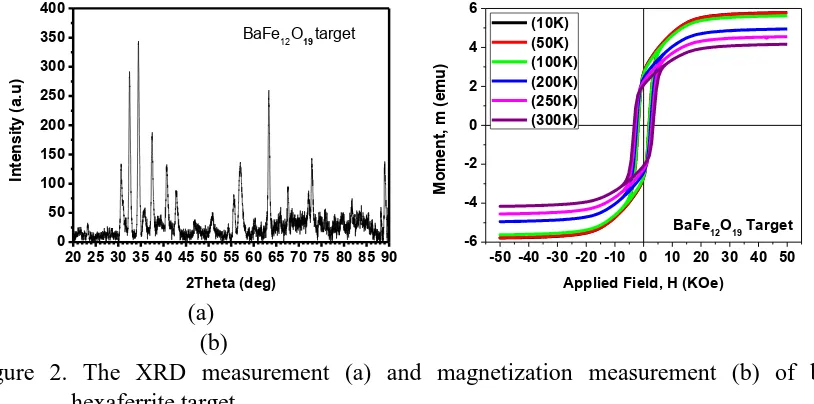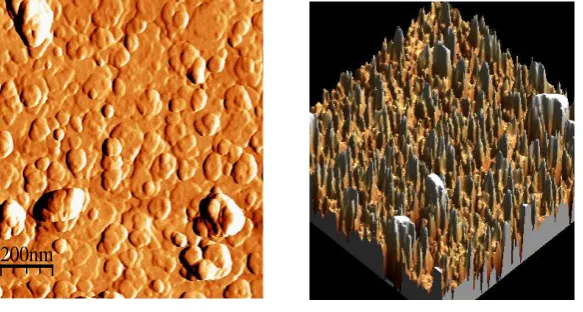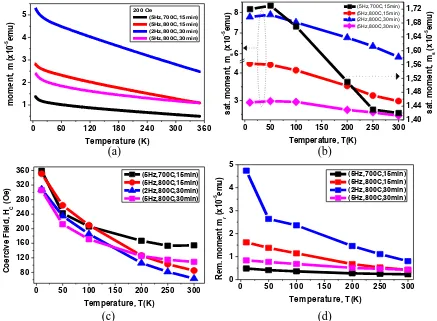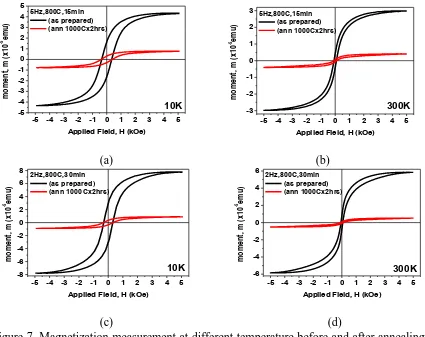1
Magnetic Properties of Barium Hexaferrite Thin Films Grown By Pulsed Laser Deposition1
Togar Saragi
Dept. of Physics, Universitas Padjadjaran Bandung, Indonesia
E-mail: [email protected]
Abstract
Barium hexaferrite BaFe12O19 (BaF) thin films have been prepared by pulsed laser deposition.
The target was prepared by solid state reaction method and the films were depositied on c-plane (0001) sapphire substrates with KrF excimer laser at wavelenght of 248 nm and with an energy density of 2.16 J/cm2. During deposition the repetition rate, the temperature, and the time for deposition were varied of: (2 Hz, 700C, 15 minutes) or sample 5715, (5 Hz, 800C, 15 minutes) or sample 5815, (5 Hz, 800C, 30 minutes) or sample 5830, (2 Hz, 800C, 30 minutes) or sample 2830 respectively. The crystal structures were measured by high resolution X-ray diffracometer (HR-XRD) and the grain size were calculated by Scherrer equation. The magnetic properties were measured using SQUID-vibrating sample magnetometer (SQUID-VSM) at a maximum 5kOe, and an atomic force microscope (AFM) was used to detected surface morfologi. The XRD measurement shows that the BHF phase was observed in the sample grown at 800C with the calculated grain size were 11.41 nm (2830) and 15.38 nm (5815). The VSM measurement shows that the: Ms,Mr and moment were increase in the series of
5715 to 5830 to 5815 and to 2830, however the Hc maximum observe at series of 5715. An AFM
image shows that the roughness average were 59.6 nm (5715), 24.6 nm (5815) and 36.9 nm (2830). After annealing at 1000C for 2 h the magnetic properties was decrease. The effects of parameter deposition and grain size and its development in the future will be discussed relation to the magnetic characteristics.
Key words: barium hexaferrite, magnetization, remnant, saturation, coercive
Introduction
Hexagonal ferrites are used widely as permanent magnets. This ferrites (ferrimagnetic transition-metal oxides) are electrically insulating, and therefore they are widely used in high-frequency applications, because an ac field does not induce undesirable eddy currents in an insulating material [1]. Barium hexaferrite, BaO.6Fe203, is a known high performance permanent magnetic
material [2], has the magnetoplumbite structure (hexagonal, P6/mmc) with cell dimensions a = 5.888 Å and c = 23.228 Å, and is ferrimagnetic with Tc = 723 K (=450C) [3]. Barium ferrite thin films have a high Curie temperature, large magnetocrystalline anisotropy field Hk, large magneto-optic rotation [4-5] and large uniaxial anisotropy ~0.33 MJ.m-3 parallel to the c-axis [6]. Owing to a high characteristics, these ferrites are especially suitable for next generation magneto-optical (MO) disk material [7], millimetre-wave filters, phase shifters and non-reciprocal devices with frequency tuning provided by an external magnetic field [8-10], Coplanar Waveguides (CPWs) in microwave integrated circuits (MICs) and in monolithic microwave integrated circuits (MMICs) [11-14] due to lower level of media noise in comparison with Co-based alloy [15]. The narrow transition width being required for high
1Presented on International Simposium on Functional Material Science (ISFMS) The Development of Advanced
2
linear densities, which is proportional to Mr t/Hc, where Mr is the remanent magnetization, t is the film thickness, and Hc is the coercivity [16], and for microwave application, it is easy to obtain the ferromagnetic resonance (FMR) frequencies in the range of 50–60 GHz with application of reasonable values of external bias magnetic fields not exceeding 10 kOe [17-23]. One superior property of barium hexaferrite is its excellent chemical stability, thermal stability [24], and corrosion resistivity [25]. Ferrite magnets are still widely used and are intensively researched to increase the saturation magnetisation as reported in [26] although they have less magnetic strength than rare earth magnets [27] and relatively low magnetisation (Ms = 0.44 T). The interested things to explore for these materials are grain size, and films thickness. The grain size ~ 50nm are desirable to realize reasonable signal-to-noise ratio (SNR) in ultrahigh density recording [28] and in magnetic recording media the thickness are usually thin (i.e. 30–300 nm). Deposition of barium hexaferrite on semiconductor substrates are usually utilize a sputtering or laser ablation technique. Jinshan Li at al.1995, reported the deposition of barium hexaferrite on Si ans ZnO/Si substrate using magnetron sputtering [29], Zailong Zhuang at al.1999, reported the deposition of barium hexaferrite on Si/SiO2/Pt (interlayer) using rf diode sputtering [30], A.Lisfi at al, 1998,
repeorted the deposition BaFel2OI9 films on Al203 single crystal substrate with (001)
orientation with and without buffer layer ZnO using PLD [31], Young-Yeal Song, at al,2003, deposited BaFe12O19 onto sapphire substrate onto sapphire subatrate using PLD 32], Zihui
Wang at al.2010, deposited of Barium Hexaferrite film onto sapphire substrate through PLD techniques [33].
In this paper we report deposition, magnetic properties, texture, and microstructure of highly c-axis barium hexaferrite thin films deposited by pulsed laser deposition method. Experimental Technique
A block diagram outlining the target and thin films preparation process are shown in fig. 1.
Preparation of thin films BaFe12O19
Weighting for 8 gr
Pulverize
3
Figure 1. Shematic diagram of preparation process for target (left) and thin films (right)
The target was prepared by solid state reaction method from precursor BaCO3 (99.997%) and
Fe2O3 (99.999%) as shown in figure 1. All the films were depositied on c-plane (0001) sapphire
substrates with KrF excimer laser at wavelenght of 248 nm and with an energy density of 2.16 J/cm2. Prior to each grow the vacuum system was evacuated down to base pressure 10-6 Torr with a turbomolecular pump. During deposition the repetition rate, the temperature, and the time for deposition were varied of: (2 Hz, 700C, 15 minutes) or sample 5715, (5 Hz, 800C, 15 minutes) or sample 5815, (5 Hz, 800C, 30 minutes) or sample 5830, (2 Hz, 800C, 30 minutes) or sample 2830 respectively. The crystal structures were measured by high resolution X-ray diffracometer (HR-XRD) and the grain size were calculated by Scherrer equation. The magnetic properties were measured using SQUID-vibrating sample magnetometer (SQUID-VSM) at a maximum 5kOe, and an atomic force microscope (AFM) was used to detected surface morfologi.
Result and Discussion
The density of the target before and after sintering are 2.7745 gr/cm3and 3.1618 gr/cm3
respectively. From XRD measurement shows that the target is polycrystalline as shown in
The remnant moment, saturation moment and coercive field are shown in table 1 Table1. The remnant moment, saturation monent and coercive field
BHF TARGET Mr (emu) Hc (Oe) Ms (emu)
4
at high T, however, the coercive field is lower. It is indicated that the samples displays a weak ferromagnetism, which may result from remnants of hexaferrite platelets or/and magnetic clusters [27].
From XRD measurement of thin films shows that the crystallization films performed at 800C as shown in figure 3.
Figure 3. The XRD measurement of barium hexaferrite thin films
The particle size is determined from the diffraction peak broadening with the use of the Scherrer equation [34]. The particle size are 11.41 nm (sample of 2830) and 15.38 nm (sample of 5815).
From AFM masurement shows that particles is nearly spherical shape without porous. With the increase in the deposition temperature the surface has a melting partial. The roughness average of the samples are 43.4 nm (sample of 5715), 24.6 nm (sample of 5815) and 36.9 nm (sample of 2830).
Figure 4. The AFM measurement of sample 5715
Magnetization measurement was done in the plane direction of the films. All samples shows the normal ferromagnetic and has been saturated at less than 5 kOe as shown in figure 5. The saturation moment, remnant moment were increase in the series of 5715 to 5830 to 5815 and to 2830, however the Hc maximum observe at series of 5715.
200nm
20 25 30 35 40 45 50 55 60 65 70 75 80
(10
7)
(00
8)
In
ten
sity (
a.u
)
2 Theta (deg)
(Al2O3 substrate) (700C,5Hz,15mnt) (800C,5Hz,15mnt) (800C,2Hz,30mnt)
(00
5
(10K) (300K)
Figure 5. Magnetization measurement at 10 K (left) and 300 K (right)
(a) (b)
(c) (d)
Figure 6. Magnetization measurement at different temperature: (a) moment, (b) saturation moment, (c) coercive field and (d) remnant moment
After annealing the magnetic properties were decreased as shown in figure 7. It is indicated that the particles size were increased and formed a multidomain or vortex state [35].
6
(a) (b)
(c) (d)
Figure 7. Magnetization measurement at different temperature before and after annealing: (a) sample of 5815 at 10K, (b) sample of 5815 at 300K, (c) sample of 2830 at 10K and (d) sample of 2830 at 30K
Acknowledgment
I would like to thank to Universitas Padjadjaran, Directorate General of Higher Education of
Republic of Indonesia (DIKTI) and Prof Ariando - Nanocore Temasek Group National University of Singapore for supporting this research.
References:
1. Nicola A Spaldin. Magnetic Materials Fundamentals and Application, 2nd Edition. Cambridge University Press, 2011;
2. T. Fujiwara, IEEE Trans. Magn. 21 (1985) 1480
3. Adelskold V., Ark. Kemi. Min. Geol. 12A, No. 29, 1 (1938)., Smit J. and Wijn H. P. J., in Ferrites, p. 194. Wiley, New York (1959)
4. Corradi A R, Speliolis D E, Bottoni G, CandolIfo D, Cccchetti A and Magoli F 1989 IEEE Trans, Magnet,25 4066
5. Kaneko Y, Sawado Y, Ohmi P, Miyamoto I and Watada A 1987 Jpn.J. Appl, Phys. SuppL 26 23
6. A.Lisfia, J.C.Lodderb, P.de Haanb, M.A.Smithers and F.J.G.Roesthuis, Barium Ferrite
7
Grown by Laser Ablation, IEEE Transactions On Magnetics, VOL. 34, NO. 4, JULY 1998, 1654-1656
7. R.K.Kotnala, Magneto-Optical Properties Of Barium Ferrite Sputtered Films, Bull, Mater. Sci., VoL 15, No. 2, April 1992, pp. 149-152
8. Adam J D, Davis L E, Dionne G F, Schloemann E F and Stitzer S N 2002 IEEE Trans. Microw. Theory Tech. 50 721,
9. Harris V G, Chen Z, Chen Y, Yoon S, Sakai T, Gieler A, Yang A, He Y, Ziemer K S, Sun N X and Vittoria C 2006 J. Appl. Phys. 99 08M911
10.Zihui Wang, Young-Yeal Song, Yiyan Sun, Joshua Bevivino, Mingzhong Wu, V.
Veerakumar, Timothy J. Fal, and Robert E. Camley, Millimeter wave phase shifter based on ferromagnetic resonance in a hexagonal barium ferrite thin film, Applied Physics Letters 97, 2010, pp. 072509(1 -3)
11.R.N. Simons, Coplanar waveguide circuits, components, and systems, John Wiley & Sons, New York, NY, 2001;
12.K. Chang, Encyclopedia of RF and microwave engineering, John Wiley & Sons, Hoboken, NJ, 2005
13.K.C. Gupta, Microstrip lines and slotlines, 2nd ed., Artech House, Norwood, MA, 1996; 14.T. Zhou, M. Le Berre, E. Benevent, A.S. Dehlinger, F. Calmon, E. Verney, S. Perrot, and
B. Payet-Gervy, Coplanar Waveguides With Or Without Barium Ferrite Thin Films, Microwave And Optical Technology Letters, Vol. 52, No. 9, 2010, pp. 2007-2010 15.Y. Chen, M. Rao, D.E. Laughlin, M.H. Kryder. Barium Ferrite Thin Films Without a
Dead Layer, IEEE Trans. Magn. 34 (1998) 1648
16.M. Williams and L. Comstock, in AZP Conference Proceedings (AIP, Woodbury, NY, 1971), Vol. 5, pp. 738-742
17.H. L. Glass, Proc. IEEE 76, 151(1988)
18.J. D. Adam, S. V. Krishnaswami, S. H. Talisa, and K. C. Yoo, J. Magn. Magn. Mater. 83, 419 (1990)
19.I. Bady, T. Collins, N. J. Monmouth, D. J. DeBitetto, and F. K. du Pre, Proc. IRE 48, 2033 (1960)
20.M. Mita, J. Phys. Soc. Jpn. 18, 155 (1949)
21.S. Kurtin, S. Foner, and B. Lax, J. Appl. Phys. 40, 818 (1969)
22.S. V. Lebedev, C. E. Patton, M. A. Wittenauer, L. V. Saraf, and R. Ramesh, J. Appl. Phys. 91, 4426 (2002)
23.S. G. Wang, S. D. Yoon, and C. Vittoria, J. Appl. Phys. 92, 6728 (2002)
24.J. Li, T.M. Gur, R. Sinclair, S.S. Rosenblum, and H. Hayashi, J. Mater. Res. 9, 1499 (1999)
25.J. Ding, W.F. Miao, P.G. McCormick, R. Street, Highcoercivity ferrite magnets prepared by mechanical alloying, Journal of Alloys and Compounds 281 (1998) 32-36
26.A. Mali, A. Ataie, Structural characterization of nanocrystalline BaFe12O19 powders synthesized by sol-gel combustion route, Scripta Materialia 53 (2005) 1065-1075 27.Yajie Chen, Ian Smith, Anton L Geiler, Carmine Vittoria, Volodymyr Zagorodnii,
Zbigniew Celinski and Vincent G Harris, Realization of hexagonal barium ferrite thick films on Si substrates using a screen printing technique, J. Phys. D: Appl. Phys. 41 (2008) pp. 095006-095006
8 28, 12, 2007, 735-742
29.E.S. Murdoch, R.F. Simmons, R. Davidson, IEEE Trans. Magn. 28 (1992) 3072
30.Jinshan Li and Robert Sinclair. Reaction-mediated texturing of barium ferrite magnetic thin films on ZnO underlayer, J. Mater. Res., Vol. 10, No. 9, Sep 1995, 2343-2349 31.Zailong Zhuang, Maithri Rao, David E. Laughlin, and Mark H. Kryder. The effect of Pt
interlayers on the magnetic and structural properties of perpendicularly oriented barium ferrite media. J. Appl. Phys., Vol. 85, No. 8, 15 April 1999, pp. 6142-6144
32.Young-Yeal Song, Sangita Kalarickal, and Carl E. Patton. Optimized Pulsed Laser
Deposited Barium Ferrite Thin Films With Narrow Ferromagnetic Resonance Linewidths. J. Appl. Phys., Vol. 94, No. 8, 15 October 2003, pp. pp. 5103-5110.
33. Zihui Wang, Young-Yeal Song, Yiyan Sun, Joshua Bevivino, Mingzhong Wu, V.
Veerakumar, Timothy J. Fal, and Robert E. Camley. Millimeter wave phase shifter based on ferromagnetic resonance in a hexagonal barium ferrite thin film. Applied Physics Letters 97, 072509(1-3), 2010.
34. Cullity B D, Elements of X-ray diffraction [M]. Reading, MA: Addition-Wesley Co, 1978: 102−356
35. Bruce M. Moskowitz. 1991. Domain Theory, Hitchhiker's Guide to Magnetism for the Environmental Magnetism Workshop. Institute for Rock Magnetism.



